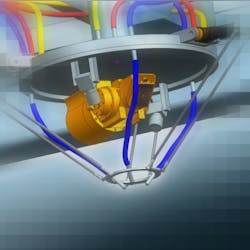FRAMOS provides vision system for flexible 3D manufacturing
Munich, Germany. As a partner in Horizon 2020, the European Union Framework Program for Research & Innovation, imaging company FRAMOS is developing a cutting-edge vision system for the BOREALIS Project.
BOREALIS began as a consortium of European partners including the Fraunhofer Institute, some renowned universities, and other industrial partners looking to provide an advanced concept for flexible machines in new additive and subtractive manufacturing processes focused on the next generation of complex 3D metal components. Overall, the concept hopes to exploit a decade of advanced R&D results in mechatronics and laser processing. With 40% less energy, 75% less material, no final machining necessary, and zero faulty parts, BOREALIS is meant to revolutionize manufacturing.
The result will be a new machine that can operate with unprecedented throughput and efficiency, true net shape, closed-loop control, and certifiable quality for large and complex products. The BOREALIS solution will be conceived specifically for industrial sectors with extremely high manufacturing costs caused by the complexity and low volume of the components being produced and by prohibitive raw material prices. As such, the BOREALIS project is looking at the medtech, aerospace, and automotive sectors as major targets for its technological breakthrough.
FRAMOS, for its part, is involved in the development of the BOREALIS machine’s sensor system, which comprises a new camera line, firmware, and pattern projector devices as well as a stereo camera system with FPGA processing and other additional features. It is primarily based on a complex vision system that monitors laser beam and powder flux quality and compensates for the large dimensional shift while also being able to move on the z-axes of the portal to handle component deposition planes and growing patterns. The mobile system consists of a thermal camera and a 3D camera system for acquiring thermally enriched 3D scenarios that mostly determine quality parameters for the laser beam and powder deposition. The two fixed locations then triangulate the overall image within the mobile system in order to synthesize a more complete geometric reconstruction of the piece being processed. An FPGA provides the system with capabilities for processing most of the captured image data directly on the camera itself, and in turn for connecting with other system sensors for the efficient transfer of processing data.
According to the project schedule, BOREALIS is to be finalized by the end of 2017 and will feature the first pilot-scale AM plant prototype as a fully integrated solution for improving 3D manufacturing. The design and modeling for the deposition-ablation processes have already been completed along with the mechatronic design of the machine. The optics and laser infrastructures have also been selected and the vision system setup has been worked out. Moreover, the basic architecture for the CAx chain has been defined and an initial draft of the final exploitation plan has already been put in place for commercializing the BOREALIS machine after the project is completed.
About the Author

Rick Nelson
Contributing Editor
Rick is currently Contributing Technical Editor. He was Executive Editor for EE in 2011-2018. Previously he served on several publications, including EDN and Vision Systems Design, and has received awards for signed editorials from the American Society of Business Publication Editors. He began as a design engineer at General Electric and Litton Industries and earned a BSEE degree from Penn State.

